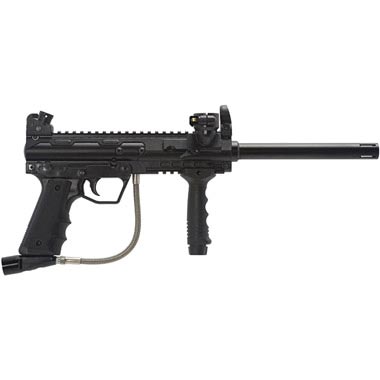3 Main Types of Paintball Guns
Jan 06, 2020

3 Main Types of Paintball Guns
Question: What are the different types of paintball guns?
Answer: Pump, Mechanical and Electronic with variations of each. Let’s dig in!
Paintball markers can be broken down into three basic types. They all have their pros and cons depending on the needs of the player. There are other types and hybrids on the market but these are the three a new player will most likely choose from.
Pump Paintball Guns
Pump paintball guns are the oldest type of gun that are seeing a resurgence in recent years. Pumps require manual operation to fire.
Typically one has to work a shotgun-like pump to cock the marker and chamber the next paintball for each shot. Pump guns, such as the Empire sniper pump gun are very reliable and make a player focus on their field skills and accuracy instead of firepower.
While playing pump is a rewarding challenge it is also the hardest way for a new player to get into the sport, especially if they are consistently up against opponents with semi-autos.
Mechanical Paintball Guns
Mechanical paintball guns are the most common markers seen in recreational play. Mechanical markers are typically semi-automatic, meaning they fire one shot per trigger pull. They are easy to maintain and can be very affordable. With the right accessories they are the easiest markers to use, the paintball equivalent of a point and shoot camera. Most mechanical markers can operate on CO2 or Compressed Air. If you’re playing at a commercial field or have a well-managed pro shop nearby then you can generally get either tanks refilled easily.
If you cannot get compressed air fills easily then you will want to make sure your marker can operate on more readily available CO2. Most mechanical markers will do so.
Most mechanical paintball guns on the market today are what are called a blowback design. When the trigger is pulled it moves a sear catch. This releases a striker or hammer that is under spring tension. The striker hits the valve, opening it long enough to propel the paintball out the barrel. The pressure from this also throws the striker back until it is caught by the sear while the next paintball falls into place in the breech.
Blowbacks tend to be either a stacktube design like Kingman Spyder guns or an inline design like Tippmann guns,BT-4s or Valken SW-1s. Stacktube designs tend to be more gas efficient so if you are playing where you cannot get air refills throughout the day you may want to consider that. Inline guns are not as gas efficient but have many more upgrade options if you decide to trick your marker out later.
Electronic Paintball Guns
Electronic paintball guns were once an expensive luxury but now are more affordable than ever. Electronic paintball markers utilize an electronic solenoid to fire the marker and are typically powered by a 9-volt battery. Instead of a long and heavy trigger pull like mechanical markers, an electronic gun’s trigger clicks a micro-switch or trips a laser beam.
Pulling the trigger is like clicking a button on a computer mouse so one can achieve very high rates of fire. A circuit board controls all the commands going to the solenoid so almost all electronic markers are capable of burst, full auto, ramping (adding extra shots the more you pull the trigger) and other firing modes. Electronic paintball guns can be broken down into three basic types: electric sear tripper, pneumatic poppet valve and spool valve.
Electric sear trippers are basically mechanical markers that use an electronic solenoid to move the sear catch. They increase the rate of fire and give you more firing mode options. They are still quick and easy to maintain just like their mechanical marker originals. Some of the more common electronic sear tripper markers include the KingmanSpyder Fenix, Tippmann A5 with E-Grip and the Empire Battle Tested BT-4
ERC.
Pneumatic poppet valves are similar to stacktube blowbacks in concept but use a pressure-powered ram instead of a striker. The result is a very fast and consistent firing paintball marker that is also very gas efficient, getting many shots per fill. The Planet Eclipse Etek4 is a classic example of this style of marker. Almost all pneumatic poppet valve markers require compressed air to fire. Using CO2 can cause permanent damage to the solenoid.
While the maintenance is simple, Spool valve markers are incredibly popular for a variety of reasons. Spool valve markers only have one moving part (the bolt) so they have virtually no recoil and very low maintenance.
They have a very low compact profile and tend to shoot very quiet. The main drawback to spool valve markers is they are typically not as gas efficient as other markers and, depending on the model, cannot use CO2 tanks (be sure to thoroughly read a marker’s description if it can use CO2 or not!). The Smart Parts Ion was a revolutionary design that brought the spool valve to the masses. Some of the more common and popular spool valve guns today include the GOG eNMEy, Empire Mini, Empire Axe, and Planet Eclipse Etha.
If you found this article helpful then you may like our paintball for beginners section, which has several more useful articles.


